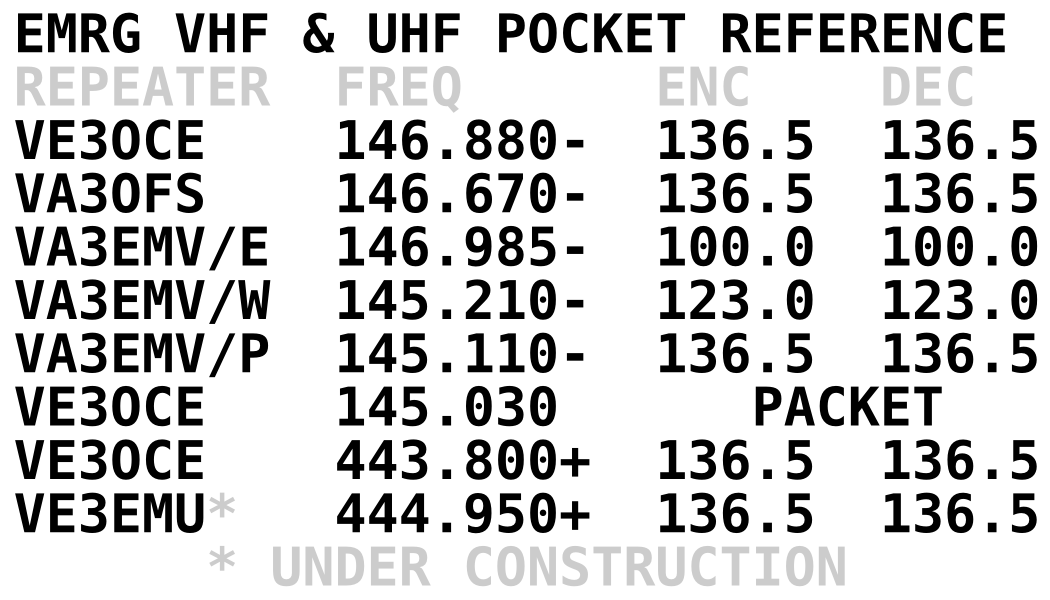On This Page
Why so many repeaters?
Why not just use club repeaters?
Aren't All Repeaters Emergency Repeaters?
Who Can Use EMRG Repeaters
EMRG Repeater Equipment
Additional Information
What Is A Repeater?
EMRG Repeater Guide
EMRG Pocket Repeater List
Building Robust Repeaters For Amateur Radio Emergency Communications
SLVRC - Repeater Council
Repeater Section EMRG Library
Introduction
Ottawa is a large city, about 85 km across (by air), so effective emergency communications requires repeaters. No one repeater can cover the whole City of Ottawa and meet all communications requirements, so EMRG has a mix of Wide Area, Regional and Community Repeaters.
- Wide Area Repeaters are required to link locations across the City and potentially beyond the City borders.
- Regional repeaters provide additional capacity within communities, or to link communities together, or to link communities with central support sites. The Regional repeaters have greater coverage than a community repeater, but not as much as a wide area repeater.
- Community repeaters provide a solution for local communications, where using a wide area repeater is not an effective use of resources. There are communities within the City which tend to define a functional unit and Community Repeaters provide coverage within these smaller functional units for local citizen patrols or for linking local sites of interest.
Why So Many Repeaters?
Some people ask "Why so many repeaters?". The reason is that EMRG is preparing for an unknown emergency, covering an unknown area of the City, which may have caused unknown damage. Not all communications functions can go on one repeater, so Hospitals for example would be on a separate repeater from shelter management and a local community patrol would be on a local repeater, not a wide area one.
The emergency may be low impact, but cover the whole City, like the Ice Storm or the Power Outage, so repeaters are required across the City. Other emergencies may be higher impact, but cover a much smaller portion of the City, so there are several repeaters required in a small area. Another issue is that depending on the type of emergency, some or all of the repeaters may have been damaged.
With enough repeater infrastructure in place, there is a good chance that there will be sufficient repeater capacity, where required, to provide effective emergency communications. Ottawa has a large number of repeaters in place today and the repeater owners willingly make their repeaters available in an emergency. EMRG repeaters fill in the gaps.
Why Not Just Use Club Repeaters?
In the past, EMRG did not own any voice repeaters, and relied on the repeater infrastructure provided by local Amateur radio clubs. This view began to change around 2002, for several reasons:
- Many local repeaters have had performance issues, have been off the air for extended periods, have aging electronics, no battery backup, the owners are aging, the club longevity is in question, and site access for the repeaters is getting difficult.
- Over time, EMRG began to better understand the requirements to provide emergency communications, the challenges in Ottawa, and the limitations of existing repeaters.
- With the amalgamation of Ottawa Fire Services and their move to the City 800MHz radio system, EMRG gained access to surplus repeater equipment and radio sites across the City.
Aren't All Repeaters Emergency Repeaters?
While in theory, any Amateur repeater could be used in an emergency, EMRG repeater strategy matches client requirements with repeater coverage and dependability. At this time, the only club repeater that is part of the EMRG operations plan, is VE2CRA VHF & UHF, because it provides wide area coverage, it is well maintained and operates on a different power grid than Ottawa.
EMRG has a document which outlines some of the requirements and expectations for a repeater to be considered for emergency use. Repeater Requirements
WHO CAN USE EMRG REPEATERS?
EMRG repeaters are open for use by anyone in the Amateur community under the following understanding:
- The purpose of the repeaters is for emergency communications, so EMRG has priority for exercises and emergencies.
- Like any public place, conversations should be useful, and free from prejudice and personal opinions. The repeaters are on City of Ottawa property and are occasionally monitored by City staff who have scanners.
- If the repeater is not working, tell someone. Notify any member of the EMRG management team, or send an email to ve3oce at rac.ca
EMRG VHF and UHF Repeaters
WHAT EQUIPMENT DOES EMRG USE FOR REPEATERS?
EMRG repeaters are made from commercial radio equipment, which can provide continuous operation and can operate from AC power or battery backup. All EMRG repeaters are located in Ottawa Fire Services (OFS) locations, which have generator backup power.
VE3OCE - VHF and UHF Voice and VHF 1200B Packet
- Location: Ottawa Fire Dispatch
- VHF Voice Repeater: Motorola MTR-2000 (30W)
- UHF Voice Repeater: Kenwood TKR-850 (25W)
- VHF Packet Repeater: Motorola Radius Mobile (25W) to be replaced by Motorola Spectra Mobile (40W)]
VA3OFS - VHF and UHF Voice and VHF 1200B Packet
- Location: Ottawa Fire Station 44
- VHF Voice Repeater: Motorola MSR-2000 (30W)
- UHF Voice Repeater: Kenwood TKR-850 (25W)
- VHF Packet Repeater: Motorola Spectra Mobile (40W)
VA3EMV/E - East End Community VHF Voice
- Location: Ottawa Fire Station 53 (Cumberland)
- VHF Voice Repeater: Receive - Motorola Radius Mobile, Transmit - Midland XTR Mobile
- Future Repeater - Motorola MSR-2000
VA3EMV/W - West End Community VHF Voice
- Location: Ottawa Fire Station 81 (Stittsville)
- VHF Voice Repeater: Motorola MTR-2000 (30W)
VA3EMV/P - Portable VHF Voice
- Location: Stored at Ottawa Fire Dispatch
- VHF Voice Repeater: Receive - Motorola Radius Mobile, Transmit - Motorola Radius Mobile
Multi-Channel Backup Repeater
- Can replace electronics for any repeater
- VHF Voice Repeater:Full Duplex Midland Syntech II
